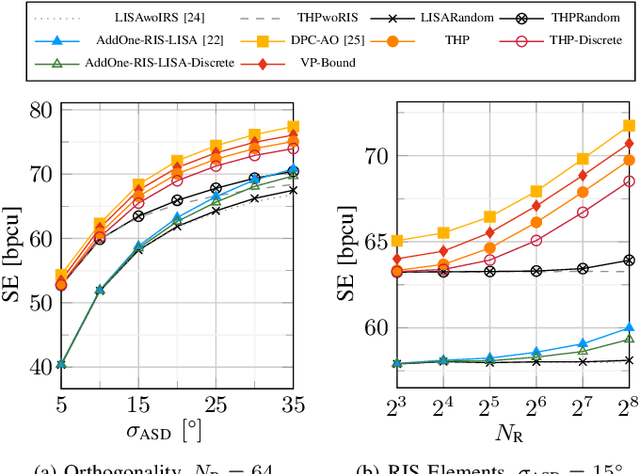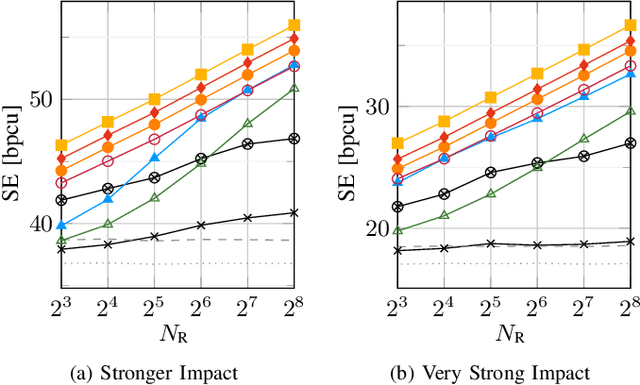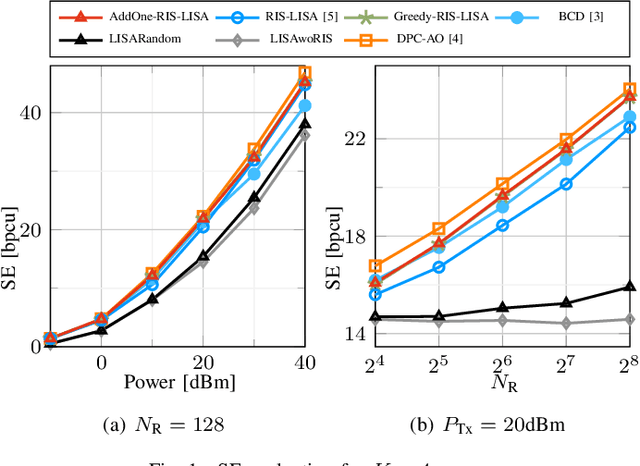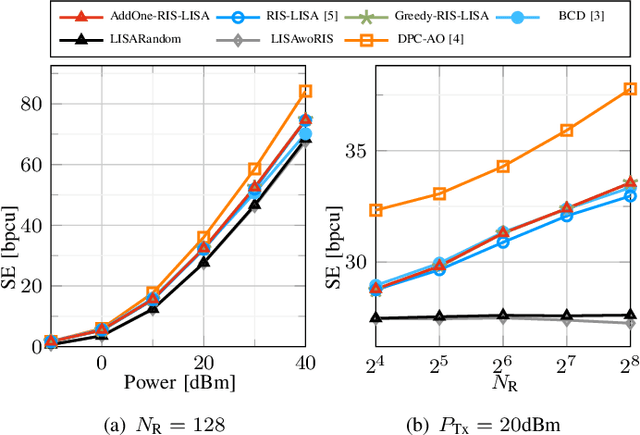Dominik Semmler
Semi-Blind Strategies for MMSE Channel Estimation Utilizing Generative Priors
Apr 24, 2025Abstract:This paper investigates semi-blind channel estimation for massive multiple-input multiple-output (MIMO) systems. To this end, we first estimate a subspace based on all received symbols (pilot and payload) to provide additional information for subsequent channel estimation. We show how this additional information enhances minimum mean square error (MMSE) channel estimation. Two variants of the linear MMSE (LMMSE) estimator are formulated, where the first one solves the estimation within the subspace, and the second one uses a subspace projection as a preprocessing step. Theoretical derivations show the superior estimation performance of the latter method in terms of mean square error for uncorrelated Rayleigh fading. Subsequently, we introduce parameterizations of this semi-blind LMMSE estimator based on two different conditional Gaussian latent models, i.e., the Gaussian mixture model and the variational autoencoder. Both models learn the underlying channel distribution of the propagation environment based on training data and serve as generative priors for semi-blind channel estimation. Extensive simulations for real-world measurement data and spatial channel models show the superior performance of the proposed methods compared to state-of-the-art semi-blind channel estimators with respect to the MSE.
Decoupling Networks and Super-Quadratic Gains for RIS Systems with Mutual Coupling
Nov 26, 2024Abstract:We propose decoupling networks for the reconfigurable intelligent surface (RIS) array as a solution to benefit from the mutual coupling between the reflecting elements. In particular, we show that when incorporating these networks, the system model reduces to the same structure as if no mutual coupling is present. Hence, all algorithms and theoretical discussions neglecting mutual coupling can be directly applied when mutual coupling is present by utilizing our proposed decoupling networks. For example, by including decoupling networks, the channel gain maximization in RIS-aided single-input single-output (SISO) systems does not require an iterative algorithm but is given in closed form as opposed to using no decoupling network. In addition, this closed-form solution allows to analytically analyze scenarios under mutual coupling resulting in novel connections to the conventional transmit array gain. In particular, we show that super-quadratic (up to quartic) channel gains w.r.t. the number of RIS elements are possible and, therefore, the system with mutual coupling performs significantly better than the conventional uncoupled system in which only squared gains are possible. We consider diagonal as well as beyond diagonal (BD)-RISs and give various analytical and numerical results, including the inevitable losses at the RIS array. In addition, simulation results validate the superior performance of decoupling networks w.r.t. the channel gain compared to other state-of-the-art methods.
Nonlinear Precoding in the RIS-Aided MIMO Broadcast Channel
Sep 04, 2024

Abstract:We propose to use Tomlinson-Harashima Precoding (THP) for the reconfigurable intelligent surface (RIS)-aided multiple-input multiple-output (MIMO) broadcast channel where we assume a line of sight (LOS) connection between the base station (BS) and the RIS. In this scenario, nonlinear precoding, like THP or dirty paper coding (DPC), has certain advantages compared to linear precoding as it is more robust in case the BS-RIS channel is not orthogonal to the direct channel. Additionally, THP and DPC allow a simple phase shift optimization which is in strong contrast to linear precoding for which the solution is quite intricate. Besides being difficult to optimize, it can be shown that linear precoding has fundamental limitations for statistical and random phase shifts which do not hold for nonlinear precoding. Moreover, we show that the advantages of THP/DPC are especially pronounced for discrete phase shifts.
A Statistical Characterization of Wireless Channels Conditioned on Side Information
Jun 06, 2024Abstract:Statistical prior channel knowledge, such as the wide-sense-stationary-uncorrelated-scattering (WSSUS) property, and additional side information both can be used to enhance physical layer applications in wireless communication. Generally, the wireless channel's strongly fluctuating path phases and WSSUS property characterize the channel by a zero mean and Toeplitz-structured covariance matrices in different domains. In this work, we derive a framework to comprehensively categorize side information based on whether it preserves or abandons these statistical features conditioned on the given side information. To accomplish this, we combine insights from a generic channel model with the representation of wireless channels as probabilistic graphs. Additionally, we exemplify several applications, ranging from channel modeling to estimation and clustering, which demonstrate how the proposed framework can practically enhance physical layer methods utilizing machine learning (ML).
High-SNR Comparison of Linear Precoding and DPC in RIS-Aided MIMO Broadcast Channels
May 29, 2024


Abstract:We compare dirty paper coding (DPC) and linear precoding methods in a reconfigurable intelligent surface (RIS)- aided high-signal-to-noise ratio (SNR) scenario, where the channel between the base station (BS) and the RIS is dominated by a line-of-sight (LOS) component. Furthermore, we consider two groups of users where one group can be efficiently served by the BS, whereas the other one has a negligible direct channel and has to be served via the RIS. These considerations allow us to analytically show fundamental differences between DPC and linear methods. In particular, our analysis addresses two essential aspects, i.e., the orthogonality of the BS-RIS channel with the direct channel and an interference term that is present only for linear precoding techniques. The interference term leads to strong limitations for the linear method, especially for random or statistical phase shifts. Moreover, we discuss under which circumstances this interference term is negligible and in which scenarios DPC and linear precoding lead to the same performance.
Design of a Multi-User RIS-Aided System with Statistical Channel Knowledge
May 14, 2024



Abstract:Reconfigurable intelligent surface (RIS) is a promising technology to enhance the spectral and energy efficiency in a wireless communication system. The design of the phase shifts of an RIS in every channel coherence interval demands a huge training overhead, making its deployment practically infeasible. The design complexity can be significantly reduced by exploiting the second-order statistics of the channels. This paper is the extension of our previous work to the design of an RIS for the multi-user setup, where we employ maximisation of the lower bound of the achievable sum-rate of the users. Unlike for the single-user case, obtaining a closed-form expression for the update of the filters and phase shifts is more challenging in the multi-user case. We resort to the fractional programming (FP) approach and the non-convex block coordinate descent (BCD) method to solve the optimisation problem. As the phase shifts of the RIS obtained by the proposed algorithms are based on the statistical channel knowledge, they do not need to be updated in every channel coherence interval.
Performance Analysis of Systems with Coupled and Decoupled RISs
Feb 23, 2024



Abstract:We analyze and compare different methods for handling the mutual coupling in RIS-aided communication systems. A new mutual coupling aware algorithm is derived where the reactance of each element is updated successively with a closed-form solution. In comparison to existing element-wise methods, this approach leads to a considerably reduced computational complexity. Furthermore, we introduce decoupling networks for the RIS array as a potential solution for handling mutual coupling. With these networks, the system model reduces to the same structure as when no mutual coupling were present. Including decoupling networks, we can optimize the channel gain of a RIS-aided SISO system in closed-form which allows to analyze the scenario under mutual coupling analytically and to draw connections to the conventional transmit array gain. In particular, a super-quadratic channel gain can be achieved which scales as N^4 where N is the number of RIS elements.
Gohberg-Semencul Estimation of Toeplitz Structured Covariance Matrices and Their Inverses
Nov 25, 2023



Abstract:When only few data samples are accessible, utilizing structural prior knowledge is essential for estimating covariance matrices and their inverses. One prominent example is knowing the covariance matrix to be Toeplitz structured, which occurs when dealing with wide sense stationary (WSS) processes. This work introduces a novel class of positive definiteness ensuring likelihood-based estimators for Toeplitz structured covariance matrices (CMs) and their inverses. In order to accomplish this, we derive positive definiteness enforcing constraint sets for the Gohberg-Semencul (GS) parameterization of inverse symmetric Toeplitz matrices. Motivated by the relationship between the GS parameterization and autoregressive (AR) processes, we propose hyperparameter tuning techniques, which enable our estimators to combine advantages from state-of-the-art likelihood and non-parametric estimators. Moreover, we present a computationally cheap closed-form estimator, which is derived by maximizing an approximate likelihood. Due to the ensured positive definiteness, our estimators perform well for both the estimation of the CM and the inverse covariance matrix (ICM). Extensive simulation results validate the proposed estimators' efficacy for several standard Toeplitz structured CMs commonly employed in a wide range of applications.
A Zero-Forcing Approach for the RIS-Aided MIMO Broadcast Channel
Nov 20, 2023

Abstract:We present efficient algorithms for the sum-spectral efficiency (SE) maximization of the multi-user reconfigurable intelligent surface (RIS)-aided multiple-input multiple-output (MIMO) broadcast channel based on a zero-forcing approach. These methods conduct a user allocation for which the computation is independent of the number of elements at the RIS, that is usually large. Specifically, two algorithms are given that exploit the line-of-sight (LOS) structure between the base station (BS) and the RIS. Simulations show superior SE performance compared to other linear precoding algorithms but with lower complexity.
Data-Aided Channel Estimation Utilizing Gaussian Mixture Models
Sep 11, 2023


Abstract:In this work, we propose two methods that utilize data symbols in addition to pilot symbols for improved channel estimation quality in a multi-user system, so-called semi-blind channel estimation. To this end, a subspace is estimated based on all received symbols and utilized to improve the estimation quality of a Gaussian mixture model-based channel estimator, which solely uses pilot symbols for channel estimation. Both of the proposed approaches allow for parallelization. Even the precomputation of estimation filters, which is beneficial in terms of computational complexity, is enabled by one of the proposed methods. Numerical simulations for real channel measurement data available to us show that the proposed methods outperform the studied state-of-the-art channel estimators.
 Add to Chrome
Add to Chrome Add to Firefox
Add to Firefox Add to Edge
Add to Edge